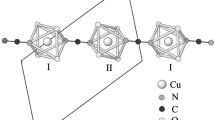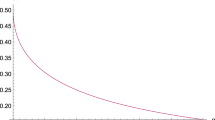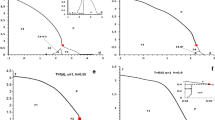Abstract
We introduce a deterministic SO(3) invariant dynamics of classical spins on a discrete space–time lattice and prove its complete integrability by explicitly finding a related non-constant (baxterized) solution of the set-theoretic Yang–Baxter equation over the 2-sphere. Equipping the algebraic structure with the corresponding Lax operator we derive an infinite sequence of conserved quantities with local densities. The dynamics depend on a single continuous spectral parameter and reduce to a (lattice) Landau–Lifshitz model in the limit of a small parameter which corresponds to the continuous time limit. Using quasi-exact numerical simulations of deterministic dynamics and Monte Carlo sampling of initial conditions corresponding to a maximum entropy equilibrium state we determine spin-spin spatio-temporal (dynamical) correlation functions with relative accuracy of three orders of magnitude. We demonstrate that in the equilibrium state with a vanishing total magnetization the correlation function precisely follows Kardar–Parisi–Zhang scaling hence the spin transport belongs to the universality class with dynamical exponent \(z=3/2\), in accordance to recent related simulations in discrete and continuous time quantum Heisenberg spin 1/2 chains.





Similar content being viewed by others
Notes
Excluding stochastic systems or any external sources of noise.
It is remarkable that integrability of this classical discrete-time model is related to the quantum Yang–Baxter equation, while its continuous-time limit (the LLL model) is related to the classical r-matrix satisfying the classical Yang–Baxter equation [11]. “Quantum-classical” correspondence in this context seems to be equivalent to a discrete-continuous time transition.
References
Klobas, K., Medenjak, M., Prosen, T., Vanicat, M.: Time-dependent matrix product ansatz for interacting reversible dynamics. Commun. Math. Phys. 371(2), 651–688 (2019)
Kardar, M., Parisi, G., Zhang, Y.-C.: Dynamic scaling of growing interfaces. Phys. Rev. Lett. 56, 889 (1986)
Spohn, H.: Nonlinear fluctuating hydrodynamics for anharmonic chains. J. Stat. Phys. 154, 1191 (2014)
Spohn, H.: Fluctuating Hydrodynamics Approach to Equilibrium Time Correlations for Anharmonic Chains. LNP, vol. 921, pp . 107–158. Springer, Berlin (2016)
Popkov, V., Schadschneider, A., Schmidt, J., Schuetz, G.M.: Fibonacci family of dynamical universality classes. Proc Natl Acad Sci USA 112, 12645 (2015)
Mendl, C.B., Spohn, H.: Dynamic correlators of Fermi–Pasta–Ulam chains and nonlinear fluctuating hydrodynamics. Phys. Rev. Lett. 111, 230601 (2013)
Kulkarni, M., Lamacraft, A.: Finite-temperature dynamical structure factor of the one-dimensional Bose gas: from the Gross–Pitaevskii equation to the Kardar–Parisi–Zhang universality class of dynamical critical phenomena. Phys. Rev. A 88, 021603(R) (2013)
Das, A., Damle, K., Dhar, A., Huse, D.A., Kulkarni, M., Mendl, C.B., Spohn, H.: Nonlinear Fluctuating Hydrodynamics for the Classical XXZ Spin Chain. arXiv:1901.00024
Ljubotina, M., Žnidarič, M., Prosen, T.: Kardar–Parisi–Zhang physics in the quantum Heisenberg magnet. Phys. Rev. Lett. 122, 210602 (2019)
Prosen, T., Žunkovič, B.: Macroscopic diffusive transport in a microscopically integrable Hamiltonian system. Phys. Rev. Lett. 111, 040602 (2013)
Faddeev, L.D., Takhtajan, L.A.: Hamiltonian Methods in the Theory of Solitons. Springer, Berlin (1987)
Das, A., Kulkarani, M., Spohn, H., Dhar, A.: Kardar–Parisi–Zhang scaling for the Faddeev–Takhtajan classical integrable spin chain. arXiv:1906.02760
Castro-Alvaredo, O.A., Doyon, B., Yoshimura, T.: Emergent hydrodynamics in integrable quantum systems out of equilibrium. Phys. Rev. X 6, 041065 (2016)
Bertini, B., Collura, M., De Nardis, J., Fagotti, M.: Transport in out-of-equilibrium XXZ chains: exact profiles of charges and currents. Phys. Rev. Lett. 117, 207201 (2016)
Dupont, M., Moore, J.E.: Universal Spin Dynamics in Infinite-Temperature One-Dimensional Quantum Magnets. arXIv:1907.12115
De Nardis, J., Bernard, D., Doyon, B.: Hydrodynamic diffusion in integrable systems. Phys. Rev. Lett. 121, 160603 (2018)
Gopalakrishnan, S., Vasseur, R.: Kinetic theory of spin diffusion and superdiffusion in XXZ spin chains. Phys. Rev. Lett. 122, 127202 (2019)
De Nardis, J., Medenjak, M., Karrasch, C., Ilievski, E.: Anomalous spin diffusion in one-dimensional antiferromagnets. arXiv:1903.07598
Gamayun, O., Miao, Y., Ilievski, E.: Domain wall dynamics in the Landau–Lifshitz magnet and the classical-quantum correspondence for spin transport. Phys. Rev. B 99, 140301 (2019)
Faddeev, L. D.: How Algebraic Bethe Ansatz Works for Integrable Model. arXiv:hep-th/9605187
Vanicat, M., Zadnik, L., Prosen, T.: Integrable trotterization: local conservation laws and boundary driving. Phys. Rev. Lett. 121, 030606 (2017)
Etingof, P., Schedler, T., Soloviev, A.: Set-theoretical solutions to the quantum Yang–Baxter equation. Duke Math. J. 100, 169 (1999)
Lu, J.H., Yan, M., Zhu, Y.C.: On the set-theoretical Yang–Baxter equation. Duke Math. J. 104, 1 (2000)
Avan, J., Caudrelier, V., Doikou, A., Kundu, A.: Lagrangian and Hamiltonian structures in an integrable hierarchy and space–time duality. Nucl. Phys. B 902, 415 (2016)
Bertini, B., Kos, P., Prosen, T.: Exact Correlation Functions for Dual-Unitary Lattice Models in 1+1 Dimensions. arXiv:1904.02140
Bertini, B., Kos, P., Prosen, T.: Exact spectral form factor in a minimal model of many-body quantum chaos. Phys. Rev. Lett. 121, 264101 (2018)
Gopalakrishnan, S., Lamacraft, A.: Unitary circuits of finite depth and infinite width from quantum channels. Phys. Rev. B 100, 064309 (2019)
Prähofer, M., Spohn, H.: Exact scaling functions for one-dimensional stationary KPZ growth. J. Stat. Phys. 115, 255 (2004)
Doyon, B.: Generalised Hydrodynamics of the classical Toda system. arXiv:1902.07624
Gopalakrishnan, S., Vasseur, R., Ware, B.: Anomalous relaxation and the high-temperature structure factor of XXZ spin chains. Proc Natl Acad Sci USA 116, 16250 (2019)
Acknowledgements
We acknowledge fruitful discussions with J. De Nardis, E. Ilievski, K. Klobas, M. Medenjak, V. Popkov, H. Spohn, M. Vanicat, M. Ljubotina and L. Zadnik. This work has been supported by the European Research Council under the Advanced Grant No. 694544—OMNES, and by the Slovenian Research Agency (ARRS) under the Programme P1-0402.
Author information
Authors and Affiliations
Corresponding author
Additional information
Communicated by Herbert Spohn.
Publisher's Note
Springer Nature remains neutral with regard to jurisdictional claims in published maps and institutional affiliations.
Appendices
Appendix A: Proof of RLL Relation
Central to the proof of integrability of the model is the RLL relation:
which we shall verify explicitly below.
The Lax matrix has been defined as:
where \(\mathbf {S}\) lies on the 2-sphere and \(\pmb {\sigma }\) is a vector of Pauli matrices:
The two-body propagator is defined as:
The propagator is a non-linear invertible mapping on a cartesian product of two 2-spheres, that takes a pair of unit vectors and transforms them according to Eq. (58).
Eq. (55) can be proven by a direct calculation, taking into account the structure of Pauli matrices. It expands as:
where the following identity has been used, \( (\mathbf {S}_1 \cdot \pmb {\sigma })( \mathbf {S}_2 \cdot \pmb {\sigma }) = (\mathbf {S}_1 \cdot \mathbf {S}_2){\mathbb {1}}+ i(\mathbf {S}_1 \times \mathbf {S}_2) \cdot \pmb {\sigma } \). Three Pauli matrices and the identity matrix form a basis of the space of \(2 \times 2\) matrices. Consequently the terms proportional to the identity and the vector of Pauli matrices in Eq. (59) must coincide independently, for the equation to hold. For the term proportional to the identity we have:
from which it follows that the identity term of Eq. (59) holds. It remains to deal with the term proportional to the vector of Pauli matrices. To this end we quickly extract the following relations from the definition of the two-body propagator:
where we have used a formula for the triple vector product: \({\mathbf {a}} \times ({\mathbf {b}} \times {\mathbf {c}}) = {\mathbf {b}} ({\mathbf {a}} \cdot {\mathbf {c}}) - {\mathbf {c}} ({\mathbf {a}} \cdot {\mathbf {b}})\). The above equations show that the sum of spins is conserved whereas their difference and vector product are interconnected. Bearing these relations in mind we rewrite the last term of Eq. (59) as:
Using Eq. (61) we easily rewrite the last expression using the initial spins:
This is precisely the coefficient of the Pauli vector term of Eq. (59) and completes the proof of the RLL equation.
Appendix B: Self-duality
The elementary temporal dynamics of the model is given by:
In this appendix we answer the following question: Given the above temporal dynamics is it possible to derive the corresponding spatial dynamics? That is, is it possible to compute the pair \(\big ({\mathbf {S}}_2^{\prime }, {\mathbf {S}}_2 \big )\) using a known pair of spins \(\big ({\mathbf {S}}_1^{\prime }, {\mathbf {S}}_1 \big )\)? We show that this is indeed possible and that such a map is unique.
If the vectors \({\mathbf {S}}_1, {\mathbf {S}}_1^{\prime }\) are linearly dependent, the dynamics are trivial. When the pair is linearly independent, the vectors \({\mathbf {S}}_1, {\mathbf {S}}_1^{\prime }, {\mathbf {S}}_1 \times {\mathbf {S}}_1^{\prime }\) span the space. We can therefore expand the vector \({\mathbf {S}}_2\) in this (in general) non-orthogonal basis:
where \(A_j\) are as of yet unknown real coefficients. From the known pair of vectors \({\mathbf {S}}_1, {\mathbf {S}}_1^{\prime }\) and the definition of the two-body propagator (64) we can compute their scalar product \(r = {\mathbf {S}}_1 \cdot {\mathbf {S}}_1^{\prime }\) and calculate:
Using the above relation a direct calculation also gives the following scalar products \({\mathbf {S}}_2 \cdot {\mathbf {S}}_1^{\prime }\), \({\mathbf {S}}_2 \cdot ({\mathbf {S}}_1 \times {\mathbf {S}}_1^{\prime })\):
Inserting the ansatz (65) for \({\mathbf {S}}_2\) gives us a connection between the coefficients \(A_j\) and \(C_j\). Since the vector \({\mathbf {S}}_1 \times {\mathbf {S}}_1^{\prime }\) is orthogonal to the vectors \({\mathbf {S}}_1\) and \({\mathbf {S}}_1^{\prime }\) coefficients \(A_3\) and \(C_3\) do not intermingle with other coefficients. The first two equations of the system (67) specify the mixing between coefficients \(A_1, A_2, C_1, C_2\), which can be cast as a system of equations:
with the solution:
The third equation of the system (67) gives:
Knowing the values of coefficients \(A_i\), we insert them into the ansatz (65) and after some simple calculations arrive at:
Since the map (1) preserves the sum of the pair of vectors:
we can also easily compute the vector \({\mathbf {S}}_2^{\prime }\). Taken together we have:
A simple calculation shows that such a map preserves the unit norm of the pair of vectors. Eq. (73) specifies a unique spatial propagator, dual to the temporal propagator (64).
Moreover, flipping the signs of vectors \({\mathbf {S}}_1, {\mathbf {S}}_2^{\prime }\) in Eq. (73):
the Eq. (73) is transformed into:
Since this map is of exactly the same form as the temporal map (64), the map is said to be space–time self-dual (see Fig. 2 of the main text). We can likewise show that flipping the sign of the other pair of vectors \({\mathbf {S}}_1^{\prime }, {\mathbf {S}}_2\) in Eq. (73) transforms it into:
This map once again has the same form as the original map (64), except that the value of the time parameter has been replaced by its negative, \(\tau \rightarrow - \tau \).
Rights and permissions
About this article
Cite this article
Krajnik, Ž., Prosen, T. Kardar–Parisi–Zhang Physics in Integrable Rotationally Symmetric Dynamics on Discrete Space–Time Lattice. J Stat Phys 179, 110–130 (2020). https://doi.org/10.1007/s10955-020-02523-1
Received:
Accepted:
Published:
Issue Date:
DOI: https://doi.org/10.1007/s10955-020-02523-1




